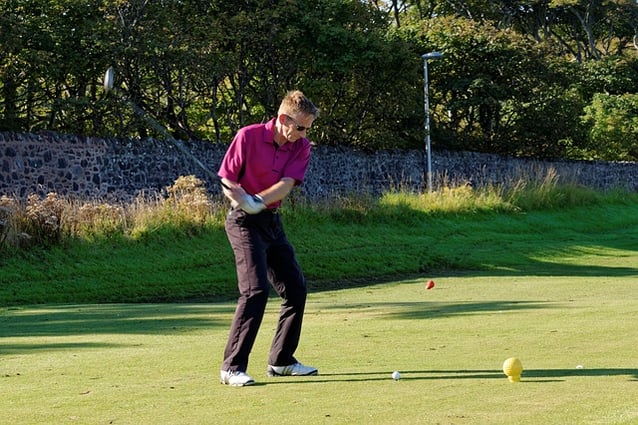
Perhaps you are struggling to make improvements to your game recently, or maybe have you been setting goals and falling short of them. Or maybe, even though you may be an avid golfer, your game just isn’t as sharp as it used to be and you want to get back to where you were. Well, we’re here to help. If you are willing to put in a little practice time, these techniques can help you play much better golf.
Transition/Synchronization
This drill is designed to eliminate the slice and the hook. Take a normal backswing. At the top of the backswing, stop. Count to 2 before starting your downswing . This will help decrease the speed of your lower body spins out of the way and help you think of your swing in sequential parts. This will help you identify unwanted movements in your downswing and give you the ability to see, feel and correct them. This drill is designed to help expose inconsistencies in velocity relating to your arms and your body. If the body is slightly ahead or behind the arms and club, then the ball will be sliced or hooked. This drill will help break timing issues by making the golfer's body move in conjunction with the club. In essence, it will help you get your golf swing in sync. And,this drill even works for the pros!
Backswing Drill: Take your normal stance with a 7-iron and place your back hand on your forward wrist. Now, move your left shoulder, left arm, left hand and the club to a backswing position where the left arm points to a “10:00 position” with the shaft at a 90-degree angle to your left arm. Now finish your swing while using your right hand to resist the left arm. This will slow down your upper body rotation, keeping your shoulders from getting too far ahead of your hands. It will help get the lower body and upper body in sync, which will create more torque and longer, better shots.
The Release
Amateurs commonly release the club too early. A key to hitting the ball with good power and direction, is having the correct release of the club at impact. Proper timing on the release will allow the wrists to stay in position long enough in the downswing. Improper timing causes the wrists to come un-set too early and compromises impact to the ball, which causes contact on the upswing with an off line clubface angle. This is a killer to distance and also direction. .
Essentially, you want the toe of your club to point straight up when you are 90 degrees into your backswing, but you also want it pointing straight up when you are 90 degrees into your follow through. Practice getting your club into those positions and you will discover more distance and greater consistency. See the drill here.
Chipping
The most important idea in chipping is to swing the clubhead at a descending angle, with the clubhead behind the hands. At impact, the shaft and body should be be leaning slightly toward the target. The hand and wrist action should be minimal. Imagine the clubhead trapping the ball against the ground. This action will pop the ball up. Remember, lean the body, lean the shaft, keep hands ahead and descend into the impact area. See this video for further explanation.
The Putter
The putter is the most often used club in the bag, so it’s important to spend the time identifying the right choice for you. Many amateurs spend big money on drivers, fairway metals and hybrids; these are all important clubs, but they are used far less often. The proper putter can help in being a proficient putter, on lag putts and short putts. Putting is a multi-faceted endeavor, but with the right flat stick, you will be more confident and consistent. Once you’ve chosen your putter, it is critical that you spend enough time practicing putts of all lengths to be prepared for the golf course. To execute on the course, you will need focus and confidence, both coming out of hours of essential practice. .
Four-Points Putting Drill: This drill was featured in “Golf Magazine Private Lessons,” which points out that doing this on a sloping part of the green means each of the four locations will present a different break and speed:
- Find a cup in a sloping part of the practice green.
- Arrange four tees around the hole, each three feet from the cup, one at each of the four points of a compass (north, south, east, west ... or, to put it another way, 12, 3, 6 and 9 on a clock).
- Start at the west, or 3 o'clock, position and make three consecutive putts. Then advance to the next location and sink three consecutive, and so on, until you've made it around the circle.
- Make 12 putts in a row (three from each location) with this drill. If you miss, then start over at the point on the compass from which the miss occurred. As you get better at making all 12, increase it to 24, or stretch the distance to four feet, and so on.



